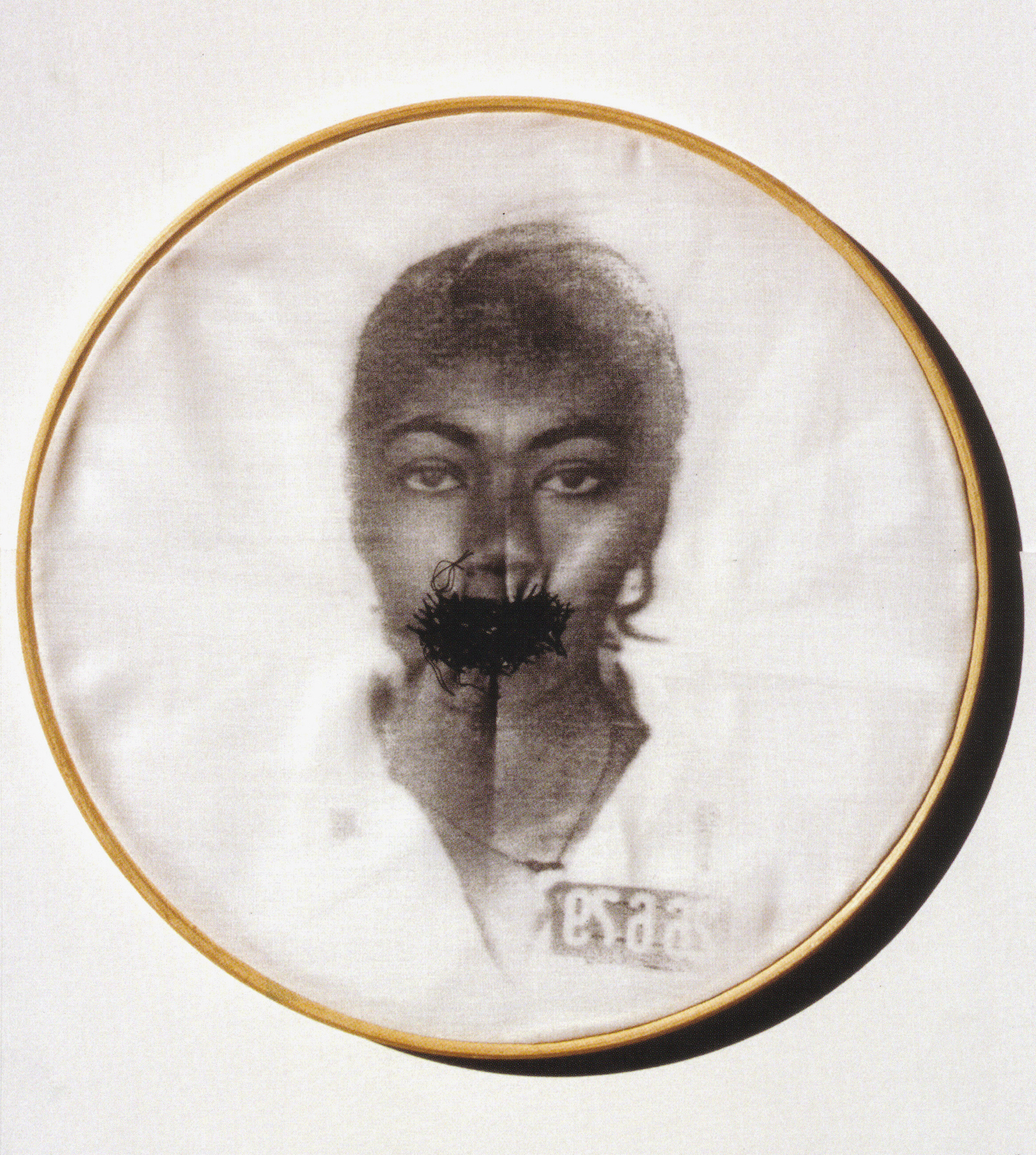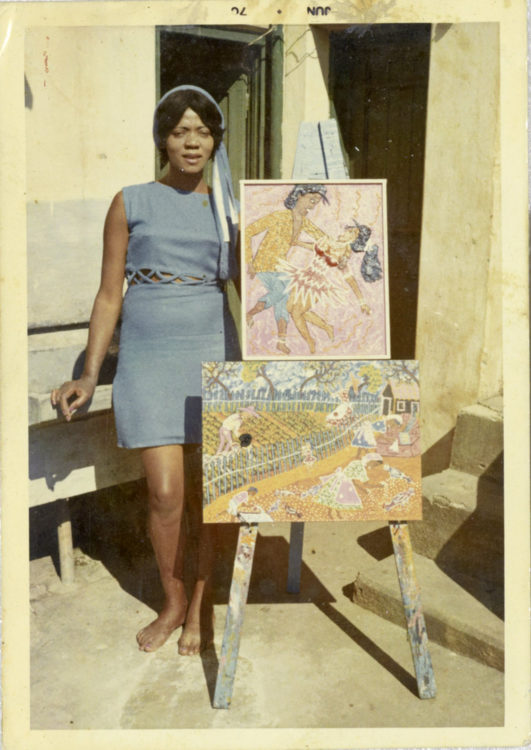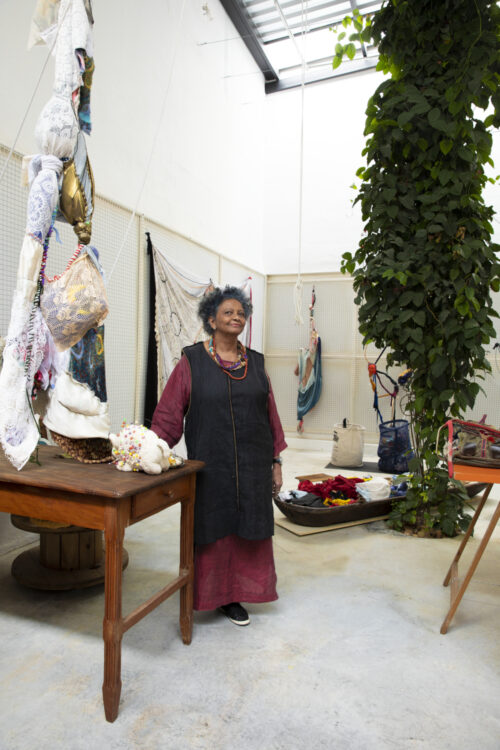Research
While Latin American art has achieved growing recognition since the 1990s, basically as a result of curatorial policies and research projects that have examined its historical, poetic and conceptual developments, African-Latin American artists – especially women – have been almost invisible until very recently.
As the Brazilian theorist Djamira Ribeiro pointed out, in agreement with the Portuguese theorist Grada Quilomba, the Black woman, who is neither white nor male, represents a double deficiency: “Black women are the ‘other’ of the ‘other’.”1 This double exclusion can be clearly seen in Latin American art history. The artist Rosana Paulino (São Paulo, 1967) pointed out that Black women are at the bottom of the social pyramid in Brazil, and almost absent in art. Her work examines the situation of Black women.2
Research and curatorial measures to take into account their contributions are recent, although this field of investigation is in full expansion. How does this process of rendering visibility function? To what degree does Latin American art history modify its concepts when it takes on board the presence of Black women artists?
Recently held exhibitions of work by Latin American women – such as Radical Women. Latin American Art, 1960-19853 – brought out the restricted presence of Black women in the field of art during that period. Although their representation continues to be insufficient, the situation has changed over the past two decades. This is attested to by two historical moments.
While, since the 1960s, there have been a few recognised Black women artists – such as Maria Lidia Magliani (Pelotas, 1946-Rio de Janeiro, 2012), whose subject in painting was the female body (sometimes that of Black women); María Auxiliadora da Silva (Campo Belo, 1935-São Paulo, 1974), a self-taught artist whose work, marked by a non-academic sensibility, took up Afro-Brazilian sociability; and Maria Adair (Itiruçu, 1938), whose abstract painting evoked nature – still, when looking deeply into that period, what stands out is an almost complete erasure of such artists in the official art world, in terms of museum exhibitions, gallery shows and collections.
The 2006 exhibition Manobras Radicais, one of the first to bring together a solid selection of work by Brazilian women, included Rosana Paulino. This exhibition and other texts have repeatedly stated that feminism is not embraced in Brazilian art4. R. Paulino herself does not identify as a feminist. While one of the feminist demands of the 1970s and ’80s was the right to work outside the home, Black women have always worked. Her mother, in fact, cleaned the homes of São Paulo feminists. But, after her sister’s sociological studies of family violence, she addressed violence against women in the series Bastidores [Frames, 1997].
At the end of the 1980s, some Brazilian shows began to give Black women artists visibility and enable them to take part in the country’s art scene. By way of an incomplete chronology, one could cite the exhibition A mão afro-brasileira: significado da contribuição artística e histórica (1988), on the occasion of the hundredth anniversary of the abolition of slavery in Brazil, organised by the Brazilian artist and curator Emanoel Araujo (Santo Amaro, 1940) at the Museo de Arte Moderno de São Paulo (MAM-SP), with work by the artists Maria Adair and María Lídia Magliani.
E. Araujo, a central figure in the transformations produced in the early twenty-first century, was the first Black head of the São Paulo Pinacoteca (1992-2002). Under his direction, the amount of work by Afro-Brazilian artists in the collection grew considerably. In 2004, he was the founding director of the Museo Afro Brasil in São Paulo, where he remains.5 In 2013, he mounted a new exhibition, A Nova Mão Afro-Brasileira, with work by 24 artists, including Rosana Paulino and Sonia Gómes (Caetanópolis, 1948).
Statistics reveal how few women have been represented among Afro-Brazilian artists. The past few years have seen consistent curatorial and institutional initiatives aiming to make Afro-Brazilian artists more visible, both those from throughout the country’s long history and among younger generations. In 2014, the exhibition Historias Mestiças, curated by Adriano Pedrosa and Lilia Moritz Schwarcz at the Museo de Arte de São Paulo and the Instituto Tomie Ohtake in the same city, highlighted a vision of Brazilian art history that subverted the canonical privileging of white abstract and formalist art. The São Paulo show Território: artistas afrodescendentes no acervo da Pinacoteca (2015-2016), curated by Tadeu Chiarelli, brought together the work of Black artists over the past two centuries.6
The year 2016 saw museological debates regarding the programming at the São Paulo Itaú cultural centre, culminating in a series of round tables (Diálogos Ausentes), with the participation, among others, of the artists Aline Motta (Niterói, 1974) and Eneida Sanches (Salvador, 1962), the curator Fabiana Lopes, and the artist and curator Diane Lima (Mundo Novo, 1986), who moderated the sessions. Among the new curatorial voices were Igor Simoes and Hélio Menezes. The event marked the emergence of a new scene of Black artists and curators. But, as F. Lopes has pointed out7, in the Black art community, measures and thinking about representation were arising from self-managed spaces, such as the programming at the Ateliê Oço/Galeria Cine Sol in São Paulo, directed by the artist and curator Claudinei Roberto da Silva (São Paulo, 1963) from 2005. For more than a decade, functioning without sponsors, this was a research lab that gave visibility to the work of Black artists and served as a platform for debate.
The 2018 exhibition Historias Afroatlánticas held at the Museu de Arte de São Paulo Assis Chateaubriand (MASP), along with the solo shows at this museum in 2018-2019, foregrounded the Afro-Atlantic narrative of the artists Maria Auxiliadora da Silva, Sonia Gomes and Lucia Laguna (Campo dos Goytacazes, 1941). In parallel, Rosana Paulino curated a group show at the São Paulo Pinacoteca (2018-2019), which then travelled to the Museu do Arte in Río de Janeiro. This chronology is testament to the transformation some Brazilian current museums are undergoing as they begin to popularise female and male Afro-Brazilian artists.
Although Brazil did not have a system of legal racism like segregation in the United States, the inequalities run deep.8 The ideologeme of “racial democracy” that hides the racism in Brazilian society, and the myth of “three races”, referring to the alleged harmony between Indigenous people, Europeans and Africans, mask a racial inequality that has been addressed over the past few years by measures to promote diversity. They include the affirmative action programmes (quotas) that universities began to implement in 2003, which had a real effect on the training of numerous artists. Discourses based on terror and racism, and the war on the poor activated by the public speeches of the current president Jair Bolsonaro, are putting these inclusionary policies in jeopardy.
Black artists have more presence in contemporary Brazilian art today than during the 20th century. In 2015, for the first time, a Black artist, Paulo Nazareth (Belo Horizonte, 1977), was invited to represent Brazil in the Latin American pavilion at the Venice Biennale. Video, photography and performance are fields with a strong Black presence among emerging artists. A necessarily incomplete list of Black women artists would include Musa Michelle Matiuzzi (São Paulo, 1983), Charlene Bicalho (João Monlevade, 1982), Priscila Rezende (Belo Horizonte, 1985), Juliana Dos Santos (São Paulo, 1987), Lídia Lisboa (Guaíra, 1970), Janaina Barros (São Paulo, 1979), Renata Felinto (São Paulo, 1978), Ana Lira (Caruarú, 1977) and Miriani Figueira (Porto Alegre, 1986), among many others.
These artists have introduced issues and concepts previously excluded from contemporary Brazilian art. One example is the cultural image of Black hair, as can be seen in the performance Bombril (2010-2018), in which Priscila Rezende confronts viewers with a literalised use of the name of a popular brand of steel wool, which is also a pejorative word for the hair of Black women, using her hair to scrub pots and pans. Sonia Gomes, Lídia Lisboa and Janaina Barros use fabrics and sewing to make work linking hand-made objects to the poetics of memory, of their memories. Memory is also a theme in the work of Aline Motta, who travelled to Nigeria in search of the story of her identity, a barefoot woman in Brazil and barefoot in Africa (Outros)fundamentos (2017-2019), in a poetic reflection on a diaspora that began four centuries ago with the introduction of slavery in Brazil. An incisive interrogation of identity has also been undertaken by Renata Felinto, whose bare feet reconfigure territories of memory [Danço na terra que piso (I dance on the ground that I walk on), 2014]. Inscription in a social site where colour, as imaginatively rendered by Juliana Dos Santos, separates. Colour and its arbitrariness, which she transposes into the key of blue.9
These Afro-Brazilian artists, trained in the language of contemporary art, make work marked by references to their subjectivities and loci of enunciation deeply infused with the legacy of slavery, the diaspora, and the structural racism of Brazilian society.
Djamila Ribeiro. “Feminismo negro para un nuevo marco civilizatorio”. Trad. Sebastián Porrua. Revista Sur, São Paulo, v. 13, n. 24, pp. 99-104, December 2016. Available at: https://sur.conectas.org/es/feminismo-negro-para-um-nuevo-marco-civilizatorio/. Consulted 31/06/2019. Also see Andrea Giunta, “El arte negro es el Brasil”, Revista Transas. Letras y artes de América latina, Universidad Nacional de San Martín, 2020. Available in English at https://www.revistatransas.com/2020/05/21/artenegro_brasil_giunta/#_ftn9. Consulted 13 July 2021.
2
Rosana Paulino, “El cuerpo es una cuestión política”, conversation with Victor da Rosa, 21 February 2018, C& América Latina, online publication, São Paulo. Available in English here. Consulted 13 July 2021.
3
Radical Women. Latin American Art, 1960-1985, co-curated by Cecilia Fajardo-Hill and Andrea Giunta (Hammer Museum, Los Angeles; Brooklyn Museum, New York; Pinacoteca de São Paulo (2017-2018).
4
Paulo Herkenhoff and Heloísa Buarque de Hollanda. Manobras Radicais, São Paulo, Centro Cultural Banco do Brasil, 2006. Maria Angélica Melendi, “To construct new houses and deconstruct old metaphors of foundation”, in Cecilia Fajardo-Hill, Andrea Giunta editors), Radical Women: Latin American Art, 1960-1985. Munich-London-New York: DelMonico Books/Prestel, 2017, pp. 229-335.
5
It holds a collection of more than de 6,000 works organised around different themes: Africa, work, slavery, the sacred and profane, Afro-Brazilian religions, history and memory, art. These paintings, sculpture, prints, photos, documents and ethnological items enable knowledge about the processes of the African diaspora and Afro-Brazilian culture.
6
Concerning this exhibition as well as Historias Afroatlánticas, the professor and curator Igor Moraes Simões made a systematic study in his doctoral thesis Vozes negras no cubo branco da arte brasileira, defended in March 2019, Universidade Federal do Rio Grande do Sul.
7
Fabiana Lopes, “Conversación con Aïsha Diallo”, in C& América Latina, 8 March 2018. Link here (consulted: 23/07/2019)
8
Lilia M. Schwarcz, O espetáculo das raças. Cientistas, instituições e questão racial no Brasil, 1870-1930. São Paulo: Companhia das Letras, 1993. Lilia M. Schwarcz, Nem preto, nem branco, muito pelo contario. Cor e raça na sociabilidade brasileria. São Paulo: Claro enigma, 2012.
9
Fabiana Lopes makes sharp analysis of the characteristics of this body of work in an essay in the catalogue of the Bienal 12 de Porto Alegre, Femenino(s). Visualidades, acciones, afectos (currently at the printer).
Andrea Giunta is a curator, writer and professor of Latin American art and modern and contemporary art at the University of Buenos Aires where she obtained her doctorate. Co-curator of the exhibition Radical Women. Latin American Art. 1960-1985 (Hammer Museum, LA, Brooklyn Museum, NY and Pinacoteca de São Paulo, 2017-2018). Chief curator of the 12th Biennial, Feminine(s). Visualities, Actions, Affects, Porto Alegre (2020) and the exhibition Puisqu’il fallait tout repenser / Pensar todo de nuevo (Rolf Gallery, Buenos Aires, 2020 / Les Rencontres d’Arles, 2021). Author of Feminismo y Arte Latinoamericano. Historias de mujeres que emanciparon el cuerpo (Siglo XXI, 2018, 7th edition 2021).
An article produced as part of the TEAM international academic network: Teaching, E-learning, Agency and Mentoring.











